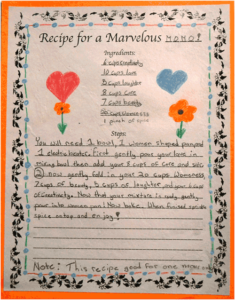Thanksgiving presents families with wonderful opportunities to express gratitude. The traditional Thanksgiving meal offers a pause from the everyday and a rare chance to gather with the express purpose of giving thanks. But what happens when Thanksgiving is over? In the U.S., the holiday season officially begins, and with it often comes a great deal of pressure and stress. We mean well, of course. We yearn to create the perfect holiday for our families, complete with a plethora of gifts. But at what price? Gratitude? Meaning? Joy? Much of that is forgotten soon after the turkey has cooled.
How do we cultivate a spirit of gratitude in our families, during the holidays and year-round, and ensure that it is not just something we proclaim during Thanksgiving?
What is Gratitude and How Does it Benefit Us?
It might help to take a step back to explore gratitude and its benefits. The Greater Good Science Center defines gratitude as having two components. The first is an affirmation of the gifts and benefits we have received. The second is an acknowledgment that the sources of those gifts exist outside of ourselves, that we have benefited from other people—or even higher powers, if that fits your belief system.
That second part is key, say the folks at Greater Good, because its social component heightens meaningful connections with others and stimulates our circuits for pleasure and reward. It also helps with entitlement issues by reinforcing to kids that happiness is a gift from others, rather than an inherent birthright.
People of all ages who practice gratitude consistently report a range of physical, psychological, and social benefits, from stronger immune systems and lower blood pressure to more joy, optimism, and compassion, and less loneliness. Research shows that practicing acts of gratitude has an immediate effect on reducing anxiety symptoms, which can be especially beneficial during challenging times. And here’s the best part: cultivating gratitude, and the happiness that results, is a skill we can teach our children.
10 Ways to Cultivate Gratitude
- Keep a gratitude journal
The simple act of recording our gratitude in writing has been linked to benefits such as better sleep, fewer symptoms of illness, and more happiness for both adults and children. Have family members keep individual gratitude journals, or keep a list as a family. Write thee to five short items weekly, naming the things you are grateful for. One exercise is to imagine what life would be like without those components. According to the Greater Good Science Center, journaling one to two times a week is actually more powerful than journaling daily. Focusing gratitude on people is more effective than focusing it on things. You may want to start journals on New Year’s Day and try to write in them throughout the year. - Practice expressing gratitude
Journaling won’t work for your family? Take time before or during meals to share things you are grateful for. The items can be profound or trivial. As with journaling, sharing needn’t occur everyday. The important thing is that kids get into the habit of expressing gratitude regularly. Parents can model gratitude by letting other family members know that they are grateful for them and their specific actions. Mornings and bedtimes also present abundant opportunities to express gratitude. Have young children greet the day by thanking the sun for rising, the air we breathe, the beautiful trees, and their family members, teachers, or neighbors. You may wish to sing a thankful “Good Morning” song. Many parents use bedtime as a quiet time for cuddling and asking children to name three things they’re grateful for. Seeking another way to help kids express gratitude for others? See below for a fun gratitude craft. - Slow down and create family time
Studies show that play time, down time, and family time are vital to kids’ and families’ well-being, benefiting every area of physical, psychological, and emotional health. Children who have unstructured time and play are more creative, collaborative, flexible, self-aware, and calm. Families who have unstructured time and play are joyful and close. Slowing allows families to savor the positive feelings and events that are a hallmark of gratitude. At holiday time and throughout the year, try to leave some down time in the schedule. That might mean reducing the number of activities each family member participates in, or turning down the occasional invitation. It may take practice to put the same value on “down time” that we do on organized, goal-oriented activity. It may be uncomfortable at first to be idle. If you have to schedule this time in a calendar, do so.
- Be a tourist in your town
Have you ever noticed how tourists are usually delighted? Granted, they’re on vacation together and they have come to their destination to have fun. But they also see everything with fresh eyes. Even if you’ve lived somewhere your whole life, there may be new things to see or do if you decide to do so like a tourist. This is a particularly wonderful activity and mindset for school breaks, when kids are home. As a bonus, there are often special holiday events and activities, like decorated store windows and homes, skating rinks, free music performances, and other things that are joyful, without impacting the family budget.
- Find adventure in your daily rounds
At any time of year, you can cultivate gratitude and stimulate positive social emotions by helping your kids see daily life as an adventure. Get up early one day and visit local businesses — watch produce and eggs get delivered to markets and restaurants, see bakers bake bagels and decorate cakes. Or take a walk and stop and say hello to neighbors, shopkeepers, mail carriers, and others who are on their own daily rounds. Feeling a part of the neighborhood and community is very important to children’s senses of security and feelings of gratitude.
- Along with thanks … giving
Service is a tremendously enriching act, for ourselves as well as for others. Studies show that people who engage in “pro-social spending” are measurably happier than those who do not. It’s not difficult to find an agency, event, or individual in your area who would welcome your help, whether for one time or on an ongoing basis. Many people especially need our help over the holidays with meal preparation and delivery, toy and book drives, companionship, and other needs. Jewish Family and Children’s Services offers many volunteer opportunities for individuals and families.
- Create a culture of giving in your family
Instead of giving traditional gifts, consider gifting in a recipient’s name to a nonprofit or other organization. Research organizations as a family and involve your children in choosing the most worthy and meaningful to them. Have your kids cull their rooms regularly for toys and clothing that can be donated to someone less fortunate, or have kids request that birthday party guests bring new or used toys or books for donation to the charity of their choice, and then deliver those items together. Consider setting aside a portion of your children’s allowances or gift money and having them choose a recipient for a donation. You can even give to JFCS’ Center for Children and Youth to help families who may not be able to afford the full cost of clinical services.
- Get outdoors
At any time of year, and especially in winter, outdoor time tends to be low on many family’s priority lists. It shouldn’t be. Research shows that nature play has been linked to improved imagination, cooperation, academic achievement, and numerous aspects of physical and psychological health. Nature also provides a terrific setting in which to slow our paces and have new and meaningful experiences that can enhance family bonds, as well as the feelings of awe and wonder that lead to increased gratitude and inner peace.
- Celebrate the winter solstice
The winter solstice (December 21 this year) provides a special opportunity to slow down, count our blessings, and experience the turning of the seasons during the hectic holiday time. Mark the year’s longest night by taking a walk, preparing a special meal, or having a family game night. Celebrate the sun’s return by eating oranges or hollowing out the center of an orange and placing a tea light or candle inside. If you have leftover Hanukkah gelt or other chocolate coins, place them in bags and surprise children with them. Take a family walk on December 22 to greet the return of longer days.
- Create an appreciation “recipe” for a special person
This craft helps kids convey a special relationship and feelings in a fun, creative way. Help your child create a recipe for a “marvelous mom” or a “delightful dad” or a “fabulous friend” or any other combination using an adjective and the person’s name or role.
-
- You’ll need: a piece of construction paper or poster board, markers and crayons or colored pencils, a ruler.
-
- Think about the attributes of the recipient that make him or her special.
- Write a heading on the paper: Recipe for a (fabulous friend or other).
- Using a ruler, draw six or more lines on which to write your various ingredients.
- Write the “ingredients” for the person, in recipe terms, such as “6 cups kindness,” “5 tablespoons love,” or whatever else you can think of.
- Leave space at the bottom to write out your instructions, also using recipe terms, like mix, add, fold, blend, and so on.
- Decorate the rest of the paper, as desired.
- My daughter did this wonderful project with her fourth grade class. Here is her “recipe”:
Susan Sachs Lipman (Suz) is the author of Fed Up with Frenzy: Slow Parenting in a Fast-Moving World.
We know that the holidays can be a difficult time, especially given world events. If you or your child could benefit from counseling or support, please contact JFCS’ Center for Children and Youth at 1-888-927-0839 or contact us online.



